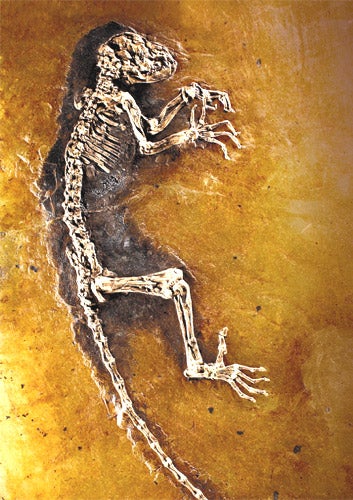Rival fossil challenges 'missing link'
Ganlea has more claim to be common primate ancestor than Ida, say scientists

She had a website devoted to her, a film made about her, a book written on her, and even a Google-page dedication of her own. But Ida the fossil primate who was supposed to be the missing link between man and the rest of the animal kingdom has been dethroned by another fossil with far better claims to the crown.
When Ida, the 47-million-year-old fossil of an early primate, was unveiled to the public in May there was near-hysteria about the discovery of the "missing link" in the ancestry of man, carefully choreographed by the publicity machine of the film company behind a television documentary sold to the BBC and the publishers of a book.
Ida, unearthed in a shale pit in Germany, was perfectly preserved right down to her opposable thumb, the fur on her back and the contents of her stomach, but now another team of scientists has questioned her right to be named as the fossil ancestor that links humans to all other animals.
Chris Beard, a palaeontologist with the Carnegie Museum of Natural History in Pittsburgh, Pennsylvania, believes that he and his team have found a far better candidate in the shape of a primate fossil found in Burma which he said is much more likely than Ida to be the common ancestor of all monkeys, apes and humans.
Called Ganlea megacanina, the new fossil is about 38 million years old and even though the scientists only have its teeth and a fragment of its jawbone they are convinced that both its anatomical features and its lifestyle are those of an "anthropoid" primate, the group of primates that split away from the other lemur-like primates to evolve into monkeys, apes and humans.
"Ida is a complete fossil, and that in many ways is its calling card. We have an incomplete fossil of Ganlea but even though it is not complete, its anatomy is far more compelling for it to be the ancestor of monkeys, apes and humans than it is for Ida to be the ancestor," Dr Beard said.
"As far as we can tell, not only is Ganlea an anthropoid, it is a fairly advanced anthropoid, which is not what you can say about Ida," he said.
A study in the Proceedings of the Royal Society shows Ganlea's large canine tooth has abrasions that could only have come about by prying open the hard exterior of tough tropical fruits in order to eat the seeds inside, an anthropoid-like behaviour seen today in South American monkeys. It has never been documented in non-anthropoid primates such as lemurs, Dr Beard said.
Other elements of its jawbone, along with anatomical features possessed by Ganlea's close Asian relatives, suggest that it belonged to the ultimate ancestral group of all anthropoids, some of which must have migrated to Africa to become the ape-like ancestors of man.
Ida, meanwhile, remains an oddity at the far end of the primate family tree, about as far away from man's ancestors as you can get, Dr Beard said. "Ida is a good-looking fossil but it was the victim of incredible marketing. It is not all that it was cracked up to be. I've never seen such hyperbole surrounding a primate fossil as the one that came with Ida – and I'm not alone in thinking that," he said.
Meet the ancestor: Ida 'over-hyped'
* Although not a direct human ancestor, Ida is still an important fossil. The most amazing aspect of Ida is her near-miraculous state of preservation – about 95 per cent of her skeleton is complete.
* She lacked a penis bone, making her unmistakably female, and her thumb and fingers were opposable which meant that she could climb and pick berries and fruit.
* Ida had a distinctive ankle bone and she lacked a "toothcomb", a fused row of teeth in the middle of the lower jaw, and a "toilet claw" used for grooming – attributes of lemurs but not monkeys.
* Her fingertips end in nails rather than claws, like monkeys, and her eye sockets are large and forward-pointing which would have given her good 3-D, binocular vision. Her large eyes would have been useful for night-time foraging in a nocturnal lifestyle.
* X-ray scans of the fossil showed that Ida had suffered a fractured wrist bone that was in the process of healing, an injury that may have led to her falling off a branch and into the lake where she was preserved in sediment.
Join our commenting forum
Join thought-provoking conversations, follow other Independent readers and see their replies
Comments
Bookmark popover
Removed from bookmarks